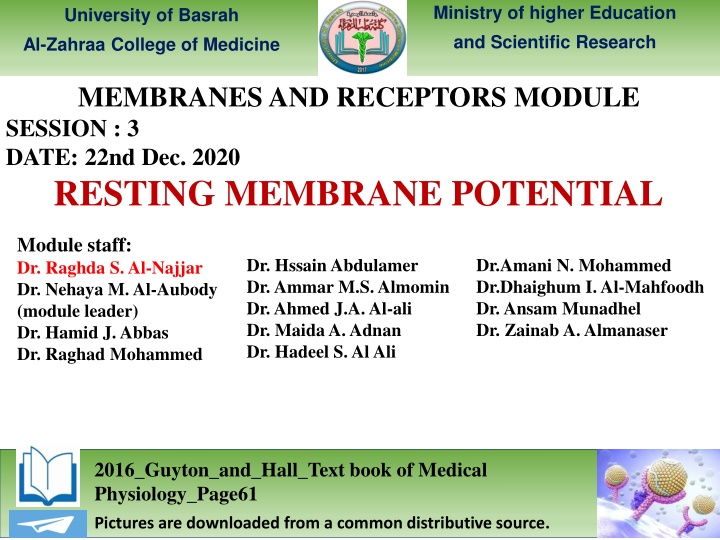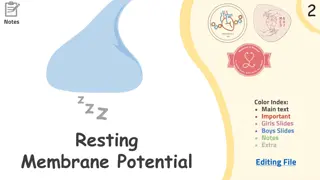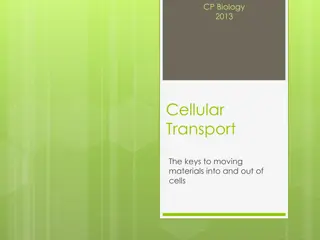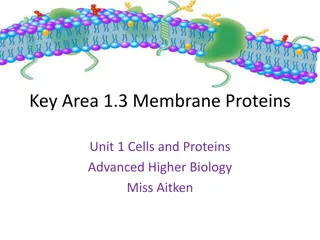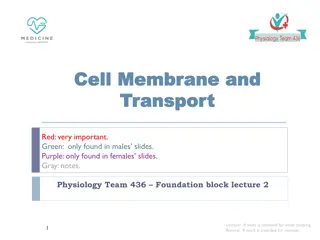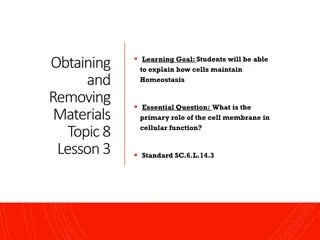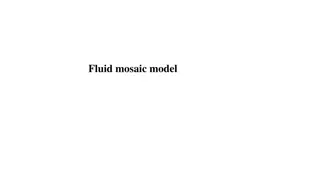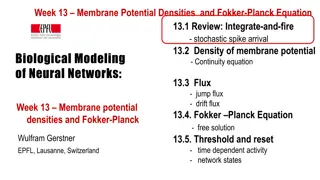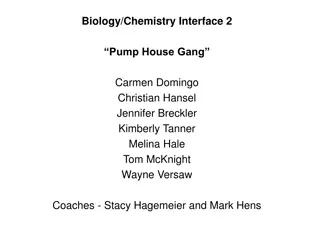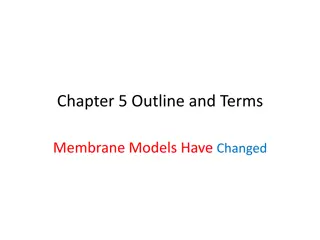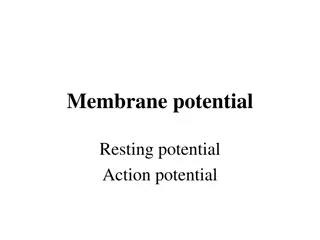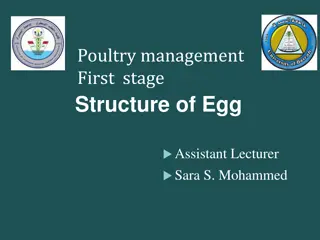RESTING MEMBRANE POTENTIAL
This session delves into the factors influencing the unequal distribution of ions, the impact on membrane potential, Nernst equations for calculating equilibrium potentials, and the role of ion permeability and Na+-K+-ATPase in resting membrane potential maintenance. Explore the effects of ion conduction changes on nerve cell potentials and the significance of Cl- permeability. Gain insights into the action potential phases and the consequences of Na+ and K+ permeability shifts in nerve and muscle membranes.
Download Presentation

Please find below an Image/Link to download the presentation.
The content on the website is provided AS IS for your information and personal use only. It may not be sold, licensed, or shared on other websites without obtaining consent from the author.If you encounter any issues during the download, it is possible that the publisher has removed the file from their server.
You are allowed to download the files provided on this website for personal or commercial use, subject to the condition that they are used lawfully. All files are the property of their respective owners.
The content on the website is provided AS IS for your information and personal use only. It may not be sold, licensed, or shared on other websites without obtaining consent from the author.
E N D
Presentation Transcript
Ministry of higher Education and Scientific Research University of Basrah Al-Zahraa College of Medicine MEMBRANES AND RECEPTORS MODULE SESSION : 3 DATE: 22nd Dec. 2020 RESTING MEMBRANE POTENTIAL Module staff: Dr. Raghda S. Al-Najjar Dr. Nehaya M. Al-Aubody (module leader) Dr. Hamid J. Abbas Dr. Raghad Mohammed Dr. Hssain Abdulamer Dr. Ammar M.S. Almomin Dr. Ahmed J.A. Al-ali Dr. Maida A. Adnan Dr. Hadeel S. Al Ali Dr.Amani N. Mohammed Dr.Dhaighum I. Al-Mahfoodh Dr. Ansam Munadhel Dr. Zainab A. Almanaser 2016_Guyton_and_Hall_Text book of Medical Physiology_Page61 Pictures are downloaded from a common distributive source.
EXERCISE 1. a) What is responsible for the unequal distribution of inorganic ions between the intracellular and extracellular fluid? b) Resting cell membranes are selectively permeable to K+. Given the concentration gradient that exists across the plasma membrane, which direction would you predict that K+ ions will move?
c) What effect will this have on membrane potential and why? d) Using the Nernst equation, calculate the K+ equilibrium potential (EK) for cells with intra- and extracellular fluid compositions as given in the Table above.
e) The actual membrane potential of a nerve cell, when measured with a microelectrode, was found to be -75 mV. Why was the measured membrane potential different to that calculated for EK? f) What would happen to the membrane potential if there was an increase in the permeability of the membrane to K+ ions ? g) What contribution does the Na+-K+-ATPase make to the maintenance of the resting membrane potential?
EXERCISE 2. a) Replace Cl- for K+ in the Nernst equation and calculate the chloride equilibrium potential (EBClB). Note: the charge on the ion being considered is negative. This should be taken into consideration in your calculation. b) What can you conclude when comparing ECl with EK ? What contribution does Cl- permeability makes in nerve cells to fixing membrane potential (relative to that of K+)? c) Some neurotransmitters act to increase Cl- conductance in the postsynaptic cell. What are the consequences of an increased Cl- conductance for the membrane potential.
EXERCISE 3. a) Calculate ENa b) During the initial phase of the action potential (electrical impulse involved in electrical excitation) in nerve and muscle plasma membranes the Na+ permeability increases so much that it becomes very much higher than that of K+. What can you predict in relation to the membrane potential ?
c) The membrane potential is restored rapidly to resting levels in nerve and muscle cells after an action potential. How do you think how this is achieved? d) What do you predict would be the effect on membrane excitability of increasing the permeability to Cl- ions?
EXERCISE 4. a) Calculate ECa. Note: the valency of Ca2+ is +2. This should be taken into consideration in your calculation. b) During the heartbeat, myocardial Ca2+ channels open and result in a substantial increase in Ca2+ permeability. In which direction does the Ca2+ flow ?
EXERCISE 5. a) In a hyperkalaemic patient, the plasma K+ concentration was found to be 7.5 mM. Assuming a similar value for the interstitial fluid, what would the consequences be for the resting cell membrane? b) Predict what the clinical consequences of such a changes might be.
